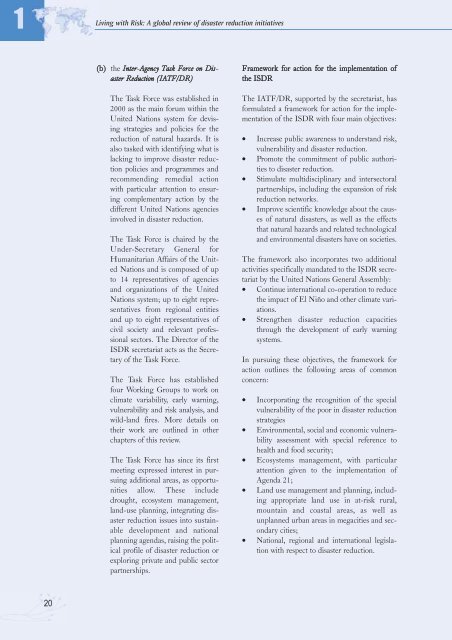A global review of disaster reduction initiatives - Welcome to the ...
A global review of disaster reduction initiatives - Welcome to the ...
A global review of disaster reduction initiatives - Welcome to the ...
You also want an ePaper? Increase the reach of your titles
YUMPU automatically turns print PDFs into web optimized ePapers that Google loves.
1Living with Risk: A <strong>global</strong> <strong>review</strong> <strong>of</strong> <strong>disaster</strong> <strong>reduction</strong> <strong>initiatives</strong>(b) <strong>the</strong> Inter-Agency Task Force on DisasterReduction (IATF/DR)The Task Force was established in2000 as <strong>the</strong> main forum within <strong>the</strong>United Nations system for devisingstrategies and policies for <strong>the</strong><strong>reduction</strong> <strong>of</strong> natural hazards. It isalso tasked with identifying what islacking <strong>to</strong> improve <strong>disaster</strong> <strong>reduction</strong>policies and programmes andrecommending remedial actionwith particular attention <strong>to</strong> ensuringcomplementary action by <strong>the</strong>different United Nations agenciesinvolved in <strong>disaster</strong> <strong>reduction</strong>.The Task Force is chaired by <strong>the</strong>Under-Secretary General forHumanitarian Affairs <strong>of</strong> <strong>the</strong> UnitedNations and is composed <strong>of</strong> up<strong>to</strong> 14 representatives <strong>of</strong> agenciesand organizations <strong>of</strong> <strong>the</strong> UnitedNations system; up <strong>to</strong> eight representativesfrom regional entitiesand up <strong>to</strong> eight representatives <strong>of</strong>civil society and relevant pr<strong>of</strong>essionalsec<strong>to</strong>rs. The Direc<strong>to</strong>r <strong>of</strong> <strong>the</strong>ISDR secretariat acts as <strong>the</strong> Secretary<strong>of</strong> <strong>the</strong> Task Force.The Task Force has establishedfour Working Groups <strong>to</strong> work onclimate variability, early warning,vulnerability and risk analysis, andwild-land fires. More details on<strong>the</strong>ir work are outlined in o<strong>the</strong>rchapters <strong>of</strong> this <strong>review</strong>.The Task Force has since its firstmeeting expressed interest in pursuingadditional areas, as opportunitiesallow. These includedrought, ecosystem management,land-use planning, integrating <strong>disaster</strong><strong>reduction</strong> issues in<strong>to</strong> sustainabledevelopment and nationalplanning agendas, raising <strong>the</strong> politicalpr<strong>of</strong>ile <strong>of</strong> <strong>disaster</strong> <strong>reduction</strong> orexploring private and public sec<strong>to</strong>rpartnerships.Framework for action for <strong>the</strong> implementation <strong>of</strong><strong>the</strong> ISDRThe IATF/DR, supported by <strong>the</strong> secretariat, hasformulated a framework for action for <strong>the</strong> implementation<strong>of</strong> <strong>the</strong> ISDR with four main objectives:• Increase public awareness <strong>to</strong> understand risk,vulnerability and <strong>disaster</strong> <strong>reduction</strong>.• Promote <strong>the</strong> commitment <strong>of</strong> public authorities<strong>to</strong> <strong>disaster</strong> <strong>reduction</strong>.• Stimulate multidisciplinary and intersec<strong>to</strong>ralpartnerships, including <strong>the</strong> expansion <strong>of</strong> risk<strong>reduction</strong> networks.• Improve scientific knowledge about <strong>the</strong> causes<strong>of</strong> natural <strong>disaster</strong>s, as well as <strong>the</strong> effectsthat natural hazards and related technologicaland environmental <strong>disaster</strong>s have on societies.The framework also incorporates two additionalactivities specifically mandated <strong>to</strong> <strong>the</strong> ISDR secretariatby <strong>the</strong> United Nations General Assembly:• Continue international co-operation <strong>to</strong> reduce<strong>the</strong> impact <strong>of</strong> El Niño and o<strong>the</strong>r climate variations.• Streng<strong>the</strong>n <strong>disaster</strong> <strong>reduction</strong> capacitiesthrough <strong>the</strong> development <strong>of</strong> early warningsystems.In pursuing <strong>the</strong>se objectives, <strong>the</strong> framework foraction outlines <strong>the</strong> following areas <strong>of</strong> commonconcern:• Incorporating <strong>the</strong> recognition <strong>of</strong> <strong>the</strong> specialvulnerability <strong>of</strong> <strong>the</strong> poor in <strong>disaster</strong> <strong>reduction</strong>strategies• Environmental, social and economic vulnerabilityassessment with special reference <strong>to</strong>health and food security;• Ecosystems management, with particularattention given <strong>to</strong> <strong>the</strong> implementation <strong>of</strong>Agenda 21;• Land use management and planning, includingappropriate land use in at-risk rural,mountain and coastal areas, as well asunplanned urban areas in megacities and secondarycities;• National, regional and international legislationwith respect <strong>to</strong> <strong>disaster</strong> <strong>reduction</strong>.20

















